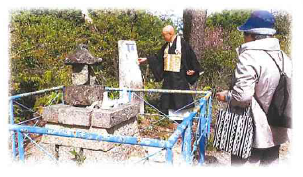有田焼の祖として有名な李参平と時代を同じくして活躍したひとりの女性がいたという。
1500年代末期、朝鮮より渡来したのち、九州で数百人もの陶工を指導し、有田焼創業にも尽力したとある女性のことは、長い歴史の間に埋もれ、人々の口から語り継がれることはほとんど無かった。資料・文献も残っておらず、本名ですら定かではない。
容貌が温和で長寿を保った彼女を、子孫は敬愛の念を込めてこう呼んだという「百婆仙(ひゃくばあせん)」。
The Legend of Baek Pasun, the endeared mother of Arita-yaki Along with Yi Sam-pyeong, the famous father of Arita-yaki, there was a woman in the same time of the history.
In late 1500s, a woman migrated from Chosun(nowadays Korea), taught several hundreds of potters in Kyushu and greatly contributed to the foundation of Arita-yaki. Yet people had forgotten and her story was lost in the long history. No historical source mentions any of her; even her real name is unclear.
The legendary woman in the deep mysteries. A warm-hearted woman who had a long life.
With great respect and love, her descendants call her “Baek Pasun”.

中国上海の南方の美しい港町、寧波。
奈良時代より大陸に渡る日本人の上陸地として知られる。
1592年4月13日、この地を終の住み処と考えていた秀吉は明を征服せんとの野望を以て、「仮道入明」の旗を立て、小西行長軍1万8千余人を先陣に、釜山に上陸し瞬く間に占領した。この有田周辺からも駆り集めたであろう兵を連れ、鍋島直茂、加藤清正軍2万2千余人は慶州へ。日本軍15万8千余人は次々に上陸。京城を始め全国の都市農村が灰となりほとんど焦土と化した。文禄の役である。
当時の日本の記録「吉野甚五左衛門覚書」には、切り付け打ち捨て、踏み殺し、女も男も犬も猫もみな切り捨てて戦神の血祭としたとある。歴史の波に飲み込まれ、多くの朝鮮の人々が犠牲となり、多くの日本兵も戦死した。
Ningbo, a beautiful port city in the south of Shanghai, China.Known as the old Japanese village in the Chinese continent from the Nara period.On April 13th 1592, Hideyoshi invaded Pusan, Korea with 18,000 soldiers of Konishi Yukinaga under the flag of “Kadounyumin”; the campaign that aimed to occupy Ningbo as the final destination of his life and to conquer Ming dynasty of China.
He also conscripted 22,000 soldiers of Nabeshima Naoshige and Kato Kiyomasa from areas including Arita and left for Gyeongju, Korea. About 158,000 soldiers landed in Korean peninsular. Almost all the cities and farm villages including Kyong-sung(nowadays, Seoul) in Korean peninsular were burned and destroyed. It was the first Japanese invasion of Korea, “Bunrokunoeki”.
According to the Japanese historical record on “Yoshino Jingozaemon Oboegaki”, they slashed, butchered, killed all the men, women, dogs and cats, as in the bloody festival of the god of war. Riding the wave of the history, many Koreans were sacrificed also many Japanese soldiers died in the war.
文禄の役の戦乱をかろうじて生き延びた百婆仙は、夫、宗伝と共に荒れた玄界灘を渡り異国の地、武雄に着いたそうです。
1616年に李参平が有田の泉山で白磁を発見しました。
1618年、百婆仙は夫はと死別します。
百婆仙はその10年余り後の1630年、70歳の頃に一族と有田に移り住みます。
朝鮮通信使が再開され、帰国する朝鮮人もいましたが、
彼女は1656年96歳で亡くなるまで故郷に帰ることなく、有田焼の母と慕われ、有田焼の生産に従事し多くの陶工のリーダーとなったといわれています。
今年は、百婆仙の没後360年になります。今まで彼女のことはあまり語られることはありませんでした。有田磁器発祥400年の節目に当たり、有田に生きた1人の女性の波乱の生涯に思いを馳せたい。彼女の魂を追慕し讃え、そして彼女が紡いだ日本と韓国の絆を深めるために2016年2月、ギャラリーペクパソンと日韓友好の館~百婆仙~を開設することになりました。
Baek Pasun barely survived the Bunrokunoeki war; with her husband Song-jun she crossed the sea of Genkai and arrived in the foreign land, Takeo.
In 1616, Yi Sam-pyeong discovered kaolin deposits in Izumiyama of Arita.
In 1618, Baek Pasun lost her husband and became a widow.
In 1630, she moved to Arita with her family at the age of 70, about ten years from her loss of her husband.
Chosun envoys had resumed and several Koreans returned to home country. She, however, did not return. She remained in Arita as the leader of potters and devoted to the production Arita-yaki until her death at the age of 96 in 1656, and was praised as the endeared mother of Arita.
This year, 2016, is the 360th year from her death. Up until now, she had not been mentioned for her achievements. In the 400th anniversary year of Arita ceramic foundation, we want to remember her as a woman who lived in Arita surviving through the turmoil of the history. To praise her soul and deepen the Japan and Korea relationship that she had founded, Gallery Baek Pasun and 日韓友好の館~百婆仙~ (正式の英語名を入れてください)were established in February 2016.

現在の武雄氏にある「国史跡肥前陶器窯跡」のひとつである小峠窯跡

武雄領主 後藤家信の庇護のもと、徳厚い武雄広福寺別宗和尚に癒され、夫婦とその一族は内田で陶器を焼いていたことであろう。

当時、故郷を偲び有田の朝鮮人陶工達が登った観音山に、今は訪れる人も少ない

